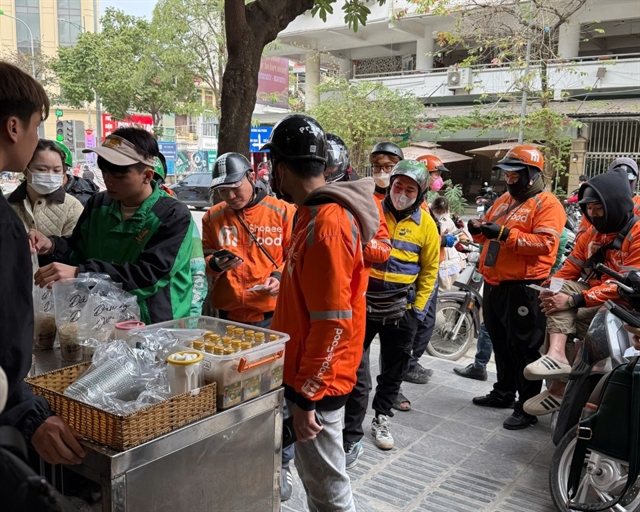With a growth rate of 14.9 per cent, Việt Nam’s food delivery market could reach US$3 billion in revenue by 2032.

The food delivery app market is heating up with the arrival of Xanh SM, adding fresh competition to the scene.
However, shop owners caution that profiting from online food stalls is no longer a game of chance or emotion — it now demands thoughtful, strategic investment and operational discipline.
According to industry experts, new restaurants entering food delivery platforms face a rising tide of expenses that threaten to erode profits.
Typical commission rates range from 25 per cent, with even the largest players facing fees of no less than 15 to 18 per cent, Managing Director of FnB Đỗ Duy Thanh told thesaigontimes.vn.
On top of this, sellers must pay a 4.5 per cent tax burden (including VAT and personal income tax), according to Thanh. To boost visibility and secure top placement on the app, restaurants often spend an additional 10-15 per cent on in-app advertising.
Combined, these costs can consume 40-45 per cent of a restaurant’s revenue on the platform. Control over customer reach via search rankings and display priority is fully held by the platform, leaving restaurants to essentially buy back their old customers through advertising spend.
Trần Quang Sang, a food app expert and representative of DigiFnB, said that commission fees on platforms such as ShopeeFood and GrabFood currently average 20-25 per cent depending on the region.
He noted that these rates were trending upward, with many vendors, especially newcomers, potentially facing charges of 25-30 per cent in the near future. With costs projected to rise another 5 per cent in 2025, profit margins would continue to shrink unless restaurants carefully adjust pricing and optimise cost structures.
However, Sang said that Việt Nam's commission rates were still lower than in regional peers such as Thailand and Singapore (both at 30 per cent) and the Philippines (at 25 per cent), so the trend toward higher platform commissions appeared inevitable.
'New tariffs raise concerns'
Representative of the Muối Chú Long coffee chain Dương Thành Long noted that while platform commission rates remained relatively stable, the food delivery channel was an essential revenue stream.
To operate effectively, the business had invested in specialised teams dedicated to managing app relationships, understanding platform policies and navigating promotional programmes.
Customer behaviour varies by region, according to Long. In Hà Nội, despite entering the market later, online revenue from just four outlets during peak months nearly matched the total online sales of 23 outlets in HCM City.
However, new tax regulations are raising concerns, restaurant owners have said.
From early June, F&B businesses are required to issue electronic invoices and pay a 4.5 per cent tax per transaction, shifting from the previous lump-sum method. Typically, platforms like ShopeeFood and GrabFood already deduct 4.5 per cent tax before transferring funds to sellers, yet businesses are still required to pay an additional 4.5 per cent when issuing invoices.
With mounting costs and shrinking margins, many shop owners fear they’ll need to raise prices, potentially alienating customers. As a result, some are opting to exit delivery platforms altogether, shifting their focus to traditional retail channels and self-managed marketing efforts, including in-store promotions and direct discounts.

More players, more opportunities
According to a report by Ipos, online food delivery was a crucial growth engine for the F&B industry in 2024, even though the percentage of F&B businesses using delivery apps dropped slightly to 52.8 per cent. This decline stemmed from a reduced number of operating outlets and ongoing disputes over commission rates between restaurants and platforms.
The representative of DigiFnB Sang said that with a growth rate of 14.9 per cent, Việt Nam’s food delivery market could reach US$3 billion in revenue by 2032. In 2025 alone, the number of food app users could surpass 17.8 million and continue climbing, making it a promising and dynamic space for platforms.
However, Vietnamese consumers remain highly price-sensitive and promotion-driven, according to Sang. New platforms must offer generous incentives to attract users, a strategy that established players also adopted in their early days. This fierce competition benefits users through more choices and better deals.
For sellers, the optimal outcome lies in increased platform support, particularly through lower commissions and larger promotional budgets to ensure sustainable operations, which is crucial during a platform's market entry phase.
The Managing Director of FnB Thanh noted that when Xanh SM launched its Xanh Ngon Merchant platform, it heavily invested in marketing to attract businesses, creating a 'golden period' lasting six to 12 months after a vendor signs up. During this time, restaurants would have a unique chance to boost revenue, increase orders and test new products.
However, this initial advantage would only last if sellers actively guide customers back to their own channels. After the promotional window closes, platforms would typically raise requirements and reduce support.
The best approach would be to leverage the platform to draw in customers, rely on service quality to keep them loyal and use private data insights to understand and anticipate user behaviour, Thanh added.
According to Ahamove co-founder and CEO Phạm Hữu Ngôn, while daily food transactions in several countries such as China and South Korea represent about one-quarter of their e-commerce sales, Việt Nam currently stands at just one-tenth.
He forecast a strong growth rate of 20-30 per cent annually over the next decade for Việt Nam’s food delivery market. VNS




